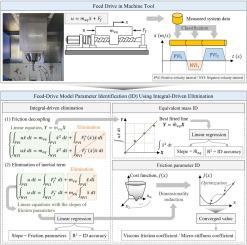基于积分驱动摩擦解耦和成本函数降维的非线性进给驱动模型参数快速识别方法
IF 4.6
2区 计算机科学
Q1 AUTOMATION & CONTROL SYSTEMS
引用次数: 0
摘要
在机床设计和控制中越来越多地使用数字孪生,需要用于模拟系统动力学的进给驱动模型。为了在数字孪生应用中实现更高的精度,需要将非线性摩擦模型(如Stribeck曲线或LuGre摩擦模型)纳入进给驱动模型中。然而,由于多变量成本函数的复杂性,识别模型参数(如等效质量和摩擦参数)的过程既耗时又具有挑战性。此外,对识别精度的定量评价也是一个挑战。提出了一种基于积分驱动消去的摩擦解耦和成本函数降维的进给驱动模型参数快速准确识别方法。在等效质量辨识中,对摩擦进行解耦,消除辨识过程中的非线性。在进给驱动模型中,等效质量是加速度系数,摩擦力是速度的函数。通过将摩擦项与加速度相乘,可以将摩擦项修改为与速度有关的保守项。利用驱动方向设置积分区间,消去摩擦项,得到的进给驱动模型成为仅由施加力和等效质量相关项组成的线性方程。这个摩擦解耦方程允许通过线性回归进行等效质量鉴定。此外,导出了用于摩擦参数识别的线性方程,其斜率对应于Stribeck和LuGre摩擦参数,不包括Stribeck速度和微刚度系数。然后将这些摩擦参数表示为斯特里贝克速度和微刚度系数的函数。得到的方程被合并到成本函数中进行迭代计算,从而降低了维数。仿真和实验结果验证了该方法的快速、准确识别能力。本文章由计算机程序翻译,如有差异,请以英文原文为准。

Rapid identification method for nonlinear feed drive model parameters using integral driven friction decoupling and dimensionality reduction of cost function
The increasing use of digital twins in machine tool design and control requires feed drive models for simulating the system dynamics. Achieving higher accuracy in digital twin applications involves incorporating nonlinear friction models, such as the Stribeck curve or LuGre friction model, into the feed drive models. However, the process of identifying model parameters, such as the equivalent mass and friction parameters, is time-consuming and challenging due to the complexity of multivariable cost functions. In addition, the quantitative evaluation of identification accuracy is challenging. This paper proposes a rapid and accurate method for identifying feed drive model parameters via integral-driven elimination-based friction decoupling and cost function dimensionality reduction. In the equivalent mass identification, friction is decoupled to eliminate the nonlinearity in the identification process. In the feed drive model, the equivalent mass is the coefficient of acceleration, and the friction is modeled as a function of velocity. The friction terms can be modified into conservative terms with respect to velocity by multiplying those with acceleration. By setting the integral interval using driving direction, the friction terms are eliminated, and the resulting feed drive model becomes a linear equation that is composed of only applied force and equivalent mass-related terms. This friction-decoupled equation allows equivalent mass identification through linear regression. In addition, linear equations are derived for friction parameter identification, with slopes corresponding to the Stribeck and LuGre friction parameters, excluding the Stribeck velocity and micro stiffness coefficients. These friction parameters are then expressed as functions of the Stribeck velocity and micro stiffness coefficient. The resulting equations are incorporated into the cost functions for iterative computations, leading to reduced dimensionality. Simulation and experimental results confirm the capability of the proposed method for rapid and accurate identification.
求助全文
通过发布文献求助,成功后即可免费获取论文全文。
去求助
来源期刊

Control Engineering Practice
工程技术-工程:电子与电气
CiteScore
9.20
自引率
12.20%
发文量
183
审稿时长
44 days
期刊介绍:
Control Engineering Practice strives to meet the needs of industrial practitioners and industrially related academics and researchers. It publishes papers which illustrate the direct application of control theory and its supporting tools in all possible areas of automation. As a result, the journal only contains papers which can be considered to have made significant contributions to the application of advanced control techniques. It is normally expected that practical results should be included, but where simulation only studies are available, it is necessary to demonstrate that the simulation model is representative of a genuine application. Strictly theoretical papers will find a more appropriate home in Control Engineering Practice''s sister publication, Automatica. It is also expected that papers are innovative with respect to the state of the art and are sufficiently detailed for a reader to be able to duplicate the main results of the paper (supplementary material, including datasets, tables, code and any relevant interactive material can be made available and downloaded from the website). The benefits of the presented methods must be made very clear and the new techniques must be compared and contrasted with results obtained using existing methods. Moreover, a thorough analysis of failures that may happen in the design process and implementation can also be part of the paper.
The scope of Control Engineering Practice matches the activities of IFAC.
Papers demonstrating the contribution of automation and control in improving the performance, quality, productivity, sustainability, resource and energy efficiency, and the manageability of systems and processes for the benefit of mankind and are relevant to industrial practitioners are most welcome.
 求助内容:
求助内容: 应助结果提醒方式:
应助结果提醒方式:


